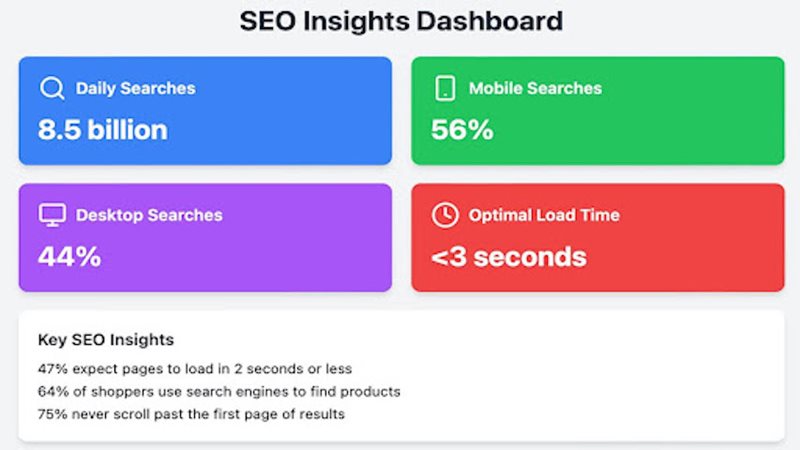Introduction: The Ever-Evolving SEO Landscape
The importance of being found online cannot be overstated. Visibility is everything! Search Engine Optimization (SEO) isn’t a technical luxury; it's an absolute necessity. Think of it as an invisible force permeating your content, whispering to search algorithms, and signaling that your website is relevant, authoritative, and deserves prime real estate near the top of search engine results pages (SERPs).
To understand the scale and importance of SEO, consider these statistics:
- Google processes approximately 3.1 trillion searches yearly—5.9 million every minute.
- On average, 2.5 quintillion bytes of data are created daily.
- About 5.47 billion people use the internet each day.
- More than 65% of global searches happen on mobile devices.
- If your page takes more than a few seconds to load, you risk losing a significant portion of your audience.
In this fiercely competitive environment, a great website isn't enough. You need SEO savvy to keep eyeballs on your content and climb the search engine rankings. Let's dive into the fundamentals of SEO to help you navigate this complex digital landscape.
Mastering SEO: The Foundation of Digital Visibility

Sources:
Before we can master content optimization, it's crucial to grasp the fundamentals of SEO—at its core, SEO enhances a website's visibility and ranking in organic search results.
SEO is the foundation on which your visibility is built. Because if they can’t find you, you don’t exist. It's the pathway to increasing your site's organic visibility, driving targeted traffic, and converting visitors into customers.
Content optimization strategically uses keywords, meta tags, and other SEO elements to make your website more attractive to search engines. It's about finding the right balance between creating engaging content for your audience and satisfying the ever-changing demands of search engine bots. This delicate balance requires a keen understanding of SEO principles, user intent, and the digital landscape.
This article aims to equip you with the knowledge and tools necessary to master content optimization for SEO. We'll explore fundamental concepts, delve into advanced techniques, and provide practical strategies you can implement to elevate your digital marketing efforts.
Let's begin!
1. SEO 101, Grasping the Essentials:
Before diving into the intricacies of content optimization, it's crucial to grasp the fundamentals of SEO.
The definition of SEO
SEO encompasses strategies and techniques designed to improve a website's visibility and ranking in organic search results. It's a key component:
- Driving organic traffic,
- Building credibility,
- Creating a sustainable, long-term online presence.
With over 3.1 trillion Google searches yearly and 5.44 billion daily internet users, SEO is not just a technical luxury—it's a necessity for online success.
Critical Components of SEO
- On-page SEO: Optimizing your web pages, content, HTML source code, and images. In 2024, this includes voice search optimization and ensuring your content aligns with Google's “Search Generative Experience” (SGE).
- Off-page SEO: Actions outside your website to impact rankings, such as building high-quality and relevant backlinks, social media engagement, and brand mentions.
- Technical SEO: Backend elements are crucial for performance across all devices, including site speed optimization, mobile-friendliness, and proper indexing.
How Search Engines Work
When a user enters a search query:
- Complex algorithms using deep learning and neural networks activate.
- Spiders crawl and index web pages.
- Pages are analyzed based on over 200 ranking factors, including content quality, relevance, and user experience.
- High-quality content will likely appear at the top of search results.
This process occurs in milliseconds, aiming to deliver results that best match the user's query and intent.
The Impact of AI on SEO
With AI-powered features like Google's SGE, SEO strategies need to focus on
- Creating comprehensive, authoritative content
- Optimizing for featured snippets and SERP features
- Focusing on long-tail keywords and natural language queries
- Enhancing E-A-T (Expertise, Authoritativeness, Trustworthiness) signals
Understanding these fundamentals and staying current with search technology developments is crucial for effective SEO in 2024 and beyond.
2. Cracking the SEO Code: Keyword Optimization
Keyword research is the foundation for successful SEO strategies. It involves understanding the language and phrases your audience will use when searching for products, services, or information related to your business.
Increasingly, it also encompasses conversational and contextual search, which describes HOW people speak and the specific contexts they search —the what, where, when, how, and why—of their searches.
Conducting Effective Keyword Research
- Start Brainstorming: Create a list of topics related to your business or industry. Try to think like your potential customers.
- Expand Your List: Use these initial ideas to develop more specific “Long-tail keywords,” which often have less competition and can drive more targeted traffic.
- Analyze Search Intent: Understand why users search for particular terms; are they looking to buy something, learn about it, or find a specific website?
- Check Competitors: See what keywords your competitors rank for to identify opportunities and gaps.
- Consider Seasonality and Trends: Some keywords may have varying search volumes throughout the year. Tools like Google Trends help identify such patterns.
Use These Tools for Keyword Analysis
Several tools can improve your keyword research:
- Google Keyword Planner: A free tool that provides search volume data and keyword suggestions.
- SEMrush: Offers comprehensive keyword analysis, including organic search, paid search, and competitor keywords.
- Ahrefs: A powerful keyword research tool with detailed metrics and SERP analysis.
- Moz Keyword Explorer: Offers keyword suggestions, SERP analysis, and an intuitive interface.
- Answer the Public: Generates questions people are asking about any given topic, which is excellent for identifying long-tail keywords.
Incorporate keywords naturally.
Once you've identified your keywords, incorporate them naturally. Place primary keywords in titles, headings, and the first paragraph. Use variations and synonyms throughout to avoid keyword stuffing and create more comprehensive content.
3. Creating High-Quality Content
In the ever-evolving world of SEO, content is king—but not just any content. Search engines are becoming increasingly sophisticated, particularly with the arrival of AI features like Google’s SGE. High-quality, relevant content is more important than ever.
The Power of Relevant and Valuable Content
Quality content:
- Builds trust and authority in your industry
- Improves user engagement, reducing bounce rates
- Earns natural backlinks, boosting SEO efforts
- Meets user intent, increasing chances of ranking well in SERPs
- Provides valuable information for AI-powered search features
Writing for Your Audience and Search Engines
- Know Your Audience: Research them and create buyer personas to map their journey and your content strategy.
- Decode User Intent: Align your content with what users are searching for—whether it’s informational (what they’re seeking), navigational (where they’re trying to go), or transactional (what they’re looking to buy).
- Be the Go-To Resource: Aim for comprehensive coverage that answers all potential questions about your topic. This approach aligns well with Google's focus on helpful content.
- Speak Their Language: Write in a way that's easy to understand and skim-read.
- Structure for Scannability: Use short paragraphs, bullet points, and subheadings.
- Embrace Multimedia: Images, videos, and infographics can enhance user experience and keep visitors engaged longer.
- Stay Fresh & Relevant: Update your content to maintain relevance—this signals to search engines that your site is active and current.
Mastering the Art of Headlines and Meta Descriptions:
In the age of information overload, your headline and meta description are your content's first impression.
Headlines Hacks:
- Load up your primary keyword near the beginning
- Spark curiosity or promise clear value
- Use numbers or power words to make your headline stand out
- Keep it snappy and aim for 50-60 characters.
Meta Description Magic:
- Craft a great summary
- Incorporate your keyword naturally
- Use active voice and include a call-to-action
- Aim for about 155-160 characters.
With the rise of AI in search, your content needs to be SEO-friendly and AI-ready. So, focus on clear, structured content that directly answers user queries. This approach will help your content perform well in traditional search results and AI-generated responses.
4. On-Page SEO Techniques: Optimizing for Humans and Algorithms
On-page SEO is where the rubber meets the road. It involves fine-tuning individual web pages to rank higher and earn more relevant traffic. These techniques focus on a page’s content and HTML source code.
Mastering Title Tags and Headers
Your title tags and headers are like signposts for users and search engines. Here's how to make them work harder for you:
Title Tag Tactics:
- Include your primary keyword near the beginning of the title.
- Keep titles under 60 characters to avoid truncation in search results.
- Make each title tag unique across your website.
- Include your brand name, typically at the end of the title.
Pro Tip: With Google's SGE, titles that answer specific questions may have an edge.
Header Hierarchy (H1, H2, H3, etc.)
- One H1 per page, please! Make it count and match your title tag intent
- Use H2s and H3s to create a clear, logical content structure
- Sprinkle relevant keywords in headers, but readability is king
- Think of your headers as a mini-outline of your content.
The Art of Link Finesse
Internal Linking Strategy:
- Create a logical site structure (think of your site as a well-organized library)
- Use descriptive, keyword-rich anchor text (no more "click here" cop-outs)
- Link to your high-value pages (spread that SEO love)
- Keep important pages within three clicks of your homepage (UX matters!)
External Linking Etiquette:
- Link to reputable, authoritative sources (the company knows you you keep)
- Use external links judiciously – quality over quantity
- Consider opening external links in new tabs (keep users on your site longer)
Readability: The User Experience Game-Changer
- Break up text into small paragraphs and use short sentences.
- Embrace lists and bullet points (like this one) for easy scanning
- Spice things up with relevant images, videos, or infographics
- Ensure your content is mobile-friendly with a responsive design.
- Compress images and minimize code to optimize page load speed.
- Choose readable fonts and maintain good contrast between text and background.

5. Technical SEO: The Invisible Advantage
Technical SEO is like the engine under the hood. It might not be immediately visible now, but it keeps you racing ahead in the SERPS. In 2024, with search engines becoming increasingly sophisticated, nailing your technical SEO is more crucial than ever.
Ensuring Mobile-Friendliness and Responsive Design
With mobile devices accounting for over half of global web traffic, mobile optimization is crucial:
- Embrace responsive design: Ensure your website adapts seamlessly to different screen sizes.
- Size matters: Make text readable and interactions easy on small screens.
- Image diet: Use appropriate sizes and formats to reduce load times on mobile networks.
- Test, test, test: Use Google's Mobile-Friendly Test tool to check your pages.
Pro Tip: With Google's mobile-first indexing, your mobile site is now your main site. Treat it that way.
Speed Demons: Improving Page Load Times
In an age of short attention spans, every second counts.
- Optimize images: Compress images and use appropriate formats.
- Code cleanse: Remove unnecessary characters and spaces from your code.
- Browser caching: Allow browsers to store some data locally to speed up subsequent page loads.
- CDN magic: Distribute your content across multiple, geographically diverse servers.
- Server speed: Optimize your server's configuration and consider upgrading your hosting if necessary.
Remember: A one-second delay in page load time can result in a 7% reduction in conversions. Speed isn't just about SEO; it's about your bottom line.
Implement Structured Data and Schema Markup
Structured data helps search engines understand the context of your content, potentially leading to rich snippets in search results:
- Choose relevant schemas: Based on your content type (e.g., Article, Product, Event), select from Schema.org’s extensive list.
- Implement JSON-LD: This is Google's preferred format for structured data.
- Use Google's Structured Data Markup Helper: This tool can help you generate the correct markup.
- Test your implementation: Use Google's Rich Results Test to ensure your markup is correct.
6. Off-Page SEO
Off-page SEO is like your website's PR campaign. It's all about actions taken outside your digital home to boost your rankings in the SERPs. In 2024, with search engines becoming increasingly sophisticated, a strong off-page SEO strategy is more crucial than ever for establishing your site's authority and trustworthiness.
The Art of High-Quality Backlinks
Backlinks remain one of the most important ranking factors. Focus on quality over quantity:
- Create link-worthy content: Develop comprehensive, unique resources that naturally attract links.
- Broken link building: Find broken links on other sites and offer your content as a replacement.
- Skyscraper technique: Identify popular content in your niche, create something better, and contact sites linking to the original.
- Resource page link building: Find resource pages in your industry and suggest your content for inclusion.
- Leverage public relations: Earn links through press releases, interviews, or expert quotes.
Pro Tip: With Google's emphasis on E-E-A-T (Experience, Expertise, Authoritativeness, Trustworthiness), backlinks from reputable, relevant sources are more valuable than ever.
Leveraging Social Media for SEO
While social media signals aren't direct ranking factors, they can indirectly benefit your SEO efforts:
- Increase content visibility: Share your content across relevant social platforms to increase exposure.
- Encourage social sharing: Make it easy for users to share your content with prominent social sharing buttons.
- Build relationships: Engage with influencers and industry leaders to increase their chances of sharing your content.
- Use social media for link prospecting: Identify potential link opportunities by monitoring industry conversations.
Engaging in Guest Blogging and Influencer Partnerships
These strategies can help you reach new audiences and earn valuable backlinks:
- Identify relevant blogs in your industry that accept guest posts.
- Pitch unique, valuable content ideas tailored to their audience.
- Create high-quality content that provides value to the host blog's readers.
- Include a natural link to your site within the content or author bio.
- Promote your guest posts through your channels to maximize exposure.
Conclusion
Mastering SEO content optimization is not a one-time task but an ongoing process of refinement and adaptation. As search engines evolve and user behaviors shift, so must your SEO strategies.
Remember These Key Takeaways:
- Understand SEO basics and stay updated on algorithm changes
- Conduct thorough keyword research and apply insights strategically
- Create high-quality, valuable content that serves both users and search engines
- Implement on-page SEO techniques to fine-tune your content
- Don't neglect technical SEO – it's the foundation of your efforts
- Build authority through off-page SEO strategies.
Remember, SEO is a long-term investment. Results may not be immediate, but consistently applying these strategies will yield significant returns. As you implement these techniques, continually analyze your results, learn from your successes and failures, and refine your approach.
In the dynamic world of digital marketing, those who master SEO’s art and science will survive and thrive. So, embrace the challenge, stay curious, and watch as your optimized content propels your business to new heights in the digital realm.



